Making your own homemade pasta dough is a delicious way to have fun in the kitchen! Fresh, homemade pasta is the absolutely best for perfect texture and ultimate sauce grabbing ability. All you need is two ingredients and a space to roll out your dough - it's that simple!
Pasta lovers throw those hands up! Or actually, put them down, dust them with flour and let's just get right down to getting messy because making your very own homemade pasta is so simple it's going to change your life for three reasons...
- You're going to say, wow that was way simpler than I thought. Maybe a little messy cause that flour sprinkles all over and my arms got a workout from the rolling pin*, but certainly easy to follow along.
- The deliciousness of homemade pasta over store-bought boxed stuff raises any pasta recipe to level 'EPIC.' it's important to note
- All you need are 2 ingredients - flour and eggs.
*this post will include short cuts if you don't feel like getting out the rolling pin.
Let's start with the flour...
When you're making homemade pasta, you start with the basics....flour and eggs. There's a lot of debate on what type of flour to use, what's best, etc. Here's the 411 on flour (do people still say that or did I just level up to granny status?)
- 00 flour - this is my favorite for making pasta. It's finely milled, has similar protein to all-purpose, but the gluten behaves a little differently resulting in super silky dough and the bite of the pasta after cooking is just perfection. You may have to order it online or see if there's a local Italian shop in your town (I get mine here in Somerville.) I particularly like this flour for long pastas - pappardelle, fettuccine, tagliatelle, etc.
- all-purpose flour - the easiest to find, works just as great, will definitely get the job done and is less expensive. Overall, this is a seriously solid way to go.
- semolina - semolina flour is more coarsely ground, has higher protein and makes pasta with more elasticity - this makes it great for pasta shapes you run through a pasta maker (aka extruded pasta) like penne, bucatini (my fav), rigatoni, etc.
Once you have your flour you just need to crack some eggs!
How to Make Homemade Pasta Dough
The best part about homemade pasta dough - besides eating it - is that you don't have to have any fancy equipment. The equipment does make things faster, but you can certainly make beautiful pasta without it.
STARTING THE DOUGH
Making the dough starts with putting the flour on a flat surface in a mound. Clear a little well in the center, wide enough to hold four eggs. If you start cracking eggs and realize it's not wide enough, carefully edge out the sides of the well without breaking it using the fork on one side and your hand on the other.
Pierce the yolks and start to whisk them together - like you're making scrambled eggs. Gradually start to pull flour from the edges of the well until the start of a very loose dough comes together.
Some troubleshooting tips:
- if the well starts to crack while whisking the eggs just push it back together
- if the well breaks completely, just quickly add the flour into the eggs and start working the dough
- the dough may seem too dry at first, just keep kneading it and the moisture will continue to spread
- if the dough still seems too dry after a bit of kneading, add a little water or olive oil and continue to knead it
- dough too sticky? If the dough is constantly sticking to your hands during kneading, even after flouring your hands and surface try kneading a little more flour into the dough 1 tablespoon at a time.
KNEADING THE DOUGH
Work the shaggy dough into a ball. Continue kneading the dough, about 5 minutes, until it forms a smooth, elastic dough. Wrap it and let it rest for 30 minutes before forming the dough. This rest time allows the gluten in the dough to develop, which gets you a more tender pasta.
Making the pasta dough in a standing mixer
Hate mess? Does the texture of flour making your skin start to prick? Looking to do this as fast as possible? Well, here's the answer.
Homemade pasta dough can easily be made in the bowl of a standing mixer with the paddle attachment. The only trick is to reduce the recipe by ¼ cup flour. When using the well and fork method, you don't incorporate all the flour but by using the stand mixer you do, by reducing the amount of flour you're keeping the wet and dry ratio the same.
Rolling out the dough by hand (without a pasta roller)
After your pasta dough has had its 30-minute nap, it's time to shape the pasta! Working on a clean, flat surface, give it a dusting of flour. If you want, you can use all-purpose for this to save some pennies or stick with the 00 flour, it's your choice.
Cut the dough into four. Cover the remaining dough pieces with a clean dishtowel or plastic wrap while you work.
Work the dough into a flat piece - aiming for a rectangular shape but don't stress too much about the shape being perfect at this point. Dust both sides with flour and begin rolling it with the rolling pin into sheets, checking occasionally to make sure it does not stick to your surface.
Roll out the piece to about 6 inches across to 10 to 12 inches long. Let the pasta sheet sit for a few minutes before giving it a light dusting of flour, again. Fold the pasta over 2 times and cut into your pasta shape! Then repeat till all your pasta is rolled and cut!
If the pasta dough starts to dry out while rolling give it a light mist of water from a spray bottle.
HOW THICK SHOULD MY PASTA BE?
This is a matter of personal preference, but you should be able to see your hand through the dough or about ⅛ inch. Someone once told me that you should be able to read a newspaper through your pasta dough. But here's two things to consider:
- I always find that when I roll the pasta by hand it naturally tends to be on the thicker side.
- Homemade pasta will thicken a little as it cooks.
Drying the pasta
If you plan to cook the pasta right away, you can skip drying the pasta. If you'd like to store the pasta and cook it another day, dry it first for about 30 minutes.
Options for drying pasta:
- purchase a pasta drying rack
- drape over the back of a chair (drape with parchment paper)
- use hangers or a dowel
Personally, I don't use a drying rack to save on gadget space so I opt for the scrappy chair/dowel option when drying my pasta. Any of those options will work!
Using a pasta machine
There are a few different spend-worthy options when it comes to pasta rolling tools. If you really love homemade pasta, it is 100% worth the investment.
You can grab a countertop pasta roller for under $50 or if you already have a standing mixer, purchase the pasta rolling attachment.
Both of these tools, as is, will only roll the pasta sheets. If you want to really increase your efficiency at pasta making, you'll also have to purchase the pasta cutting attachments or save your money and cut them by hand.
Another option, if you would like to also make extruded pasta like penne and rigatoni is to get the pasta press attachment for your standing mixer.
TIPS AND TRICKS FOR USING A PASTA MACHINE
- dust the pasta machine with flour
- flatten ¼ of the pasta dough into a disk that's thinner along the edge than the center
- roll through the pasta roller on the widest setting
- fold into three and roll
- roll the pasta sheet through 2 to 3 times, rotating the side you start with, increasing the thinness until the pasta sheet is ⅛-inch in thickness (about a 6 on the KitchenAid attachment)
- dust off the pasta machine after use - do not use water
How to Cook Homemade Pasta Dough
There's just nothing like it! The tender bite of homemade pasta is above anything else, but cooking it is just a smidge different than boxed pasta. Here are some tips for perfectly cooked pasta:
- water should be at a 'rolling boil'
- salt the water - be generous
- stir the pasta after adding to the water - make sure it doesn't stick!
- have a colander ready
- depending on thickness and type of pasta, you'll only need to cook 90 seconds to 4 minutes
- for most long pasta, about 2 minutes does the trick
- pasta will start to float to the top of the water
- reserve some of the starchy pasta water before draining if you want to use a thickener in your sauce(!)
YOU. GOT. THIS.
Not sure how you want to dish out your tender bites of perfection? Consider some of these recipes for swoon-worthy sauces:
- Spicy Arrabiatta Sauce
- Brown Butter Sage Sauce
- Short Rib Bolognese
- Meyer Lemon Basil Pesto
- Marsala Cream Sauce
- Instant Pot Lamb Ragu
- or check out all the pasta and sauces resources on the blog right here!
How to store fresh pasta
You did all the work, maybe you don't have the time to cook it right now. Or maybe you're being awesome and doing your prep in advance.
Store the fresh pasta in the refrigerator for up to 2 days. If you can't get to make it before then, layer on parchment paper in an airtight storage container and freeze for up to 3 months.
Whether or not you put it in the fridge or the freezer, dry it first, dust into with flour or semolina and then gently fold it into nests. Layer the fresh pasta on parchment paper in an airtight container.
Congrats on becoming a homemade pasta master!
Tell us in the comments what pasta you're going to make first! If you made this recipe please leave a rating and a comment below. Don't forget to post a picture of your eats to the pin on Pinterest!

How to Make Homemade Pasta
Ingredients
- 2 ¼ to 2 ½ cups 00 flour or all purpose flour (see instructions)
- 4 large eggs
- additional flour for rolling
Instructions
Making the dough by hand:
- On a flat surface, place 2 ½ cups flour in a mound. Create a well in the center of the dough for the eggs, about 5 inches wide.
- Add the eggs to the well and pierce each yolk with a fork. Start whisking the eggs with the fork, gradually incorporating flour from the sides of the well. Once the yolks are thickened, add more and more flour. If the well starts to crack while whisking in the eggs just push it back together. If the well breaks completely, just quickly add the flour into the eggs and start working the dough with your hands.
- Once a 'shaggy dough' starts to form, stop using the fork and start working the dough into a ball using your hands.
- Knead the dough for 5 minutes. Wrap with plastic wrap and let it rest for 30 minutes.
Making the dough in a stand mixer:
- In the bowl of a stand mixer fitted with the paddle attachment, add 2 ¼ cups flour and eggs. Mix on low speed until the eggs are incorporated and increase to medium-high speed. Beat for 5 minutes until the dough is smooth and elastic.
- Wrap the dough with plastic wrap and let rest for 30 minutes.
Rolling the pasta dough:
- Unwrap the dough and cut into 4 equal pieces. Keep any pasta you are not working with covered with a clean kitchen towel or plastic wrap.
- If rolling by hand, flatten one of the pieces into a rectangle and roll out on a flat floured surface until about 6 inches wide and ⅛-inch in thickness. Cut into 10 to 12 inch length strips. Let the pasta sheets dry for 2 minutes before dusting with flour or semolina before cutting.
- To cut the pasta, fold the pasta sheet over on itself and cut to your desired pasta shape. Drape the cut pasta over a drying rack. Repeat the process until all the pasta is cut. Dry for 30 minutes before storing. If cooking right away, you can skip the drying process.
- If using a pasta rolling machine or attachment, flatten one piece of the pasta dough into a disk that's thinner along the edge and slightly thicker in the center. Dust the roller with flour and feed the dough through on the widest setting. Fold the dough into thirds and repeat. Feeding the dough into the roller 2 to 3 times per setting, rotating which side of the dough you start with until the dough is ⅛ inch thick.
- Dust the pasta sheet with flour or semolina and cut into 10 to 12 inch sheets. fold the pasta sheet over on itself and cut to your desired pasta shape for linguine, tagliatelle, etc. Drape the cut pasta over a drying rack. Dry for 30 minutes before storing. If cooking right away, you can skip the drying process. Repeat the process until all the pasta is cut.
Cooking the pasta:
- Bring a large pot of generously salted water to a rolling boil. Have a colander ready.
- Add the pasta to the water, stirring to make sure it doesn't stick together. Depending on your pasta shape, the pasta will take 90 seconds to 4 minutes to cook. Fresh pasta will start to rise to the top of the water once it's cooked.
- Reserve some of the starchy pasta water before draining if you want an easy thickener for your sauce. Drain the pasta and toss with your favorite sauce.
Storing homemade pasta:
- Dust the cut pasta with flour. Drape over a drying rack and dry for 30 minutes. Fold the pasta into little nests. Line an airtight container with parchment paper.
- Fresh pasta can be refrigerated for 2 days and stored in the freezer up to 3 months.
Notes
- 00 flour is more finely milled and preferred for pasta making, but all-purpose flour will work great as well
- you won't use all the flour when making the pasta using the well and whisk method (uses 2 ½ cups flour), so if opting to making the dough in the standing mixer reduce the total amount used (2 ¼ cups flour.)
- The dough may seem too dry at first, just keep kneading it and the moisture will continue to spread. If the dough still seems too dry after a bit of kneading, add a little water or olive oil and continue to knead it. If the dough is constantly sticking to your hands during kneading, even after flooring your hands and surface try kneading a little more flour into the dough 1 tablespoon at a time.
- If you've never made homemade pasta before, I'd highly highly recommend reading through this post for all the tips, tricks and troubleshooting steps.
Nutrition

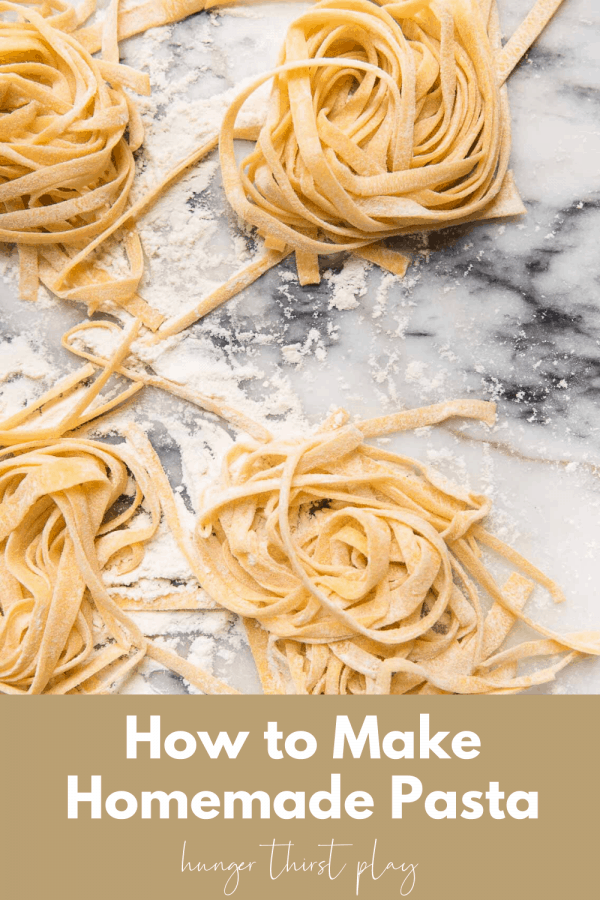
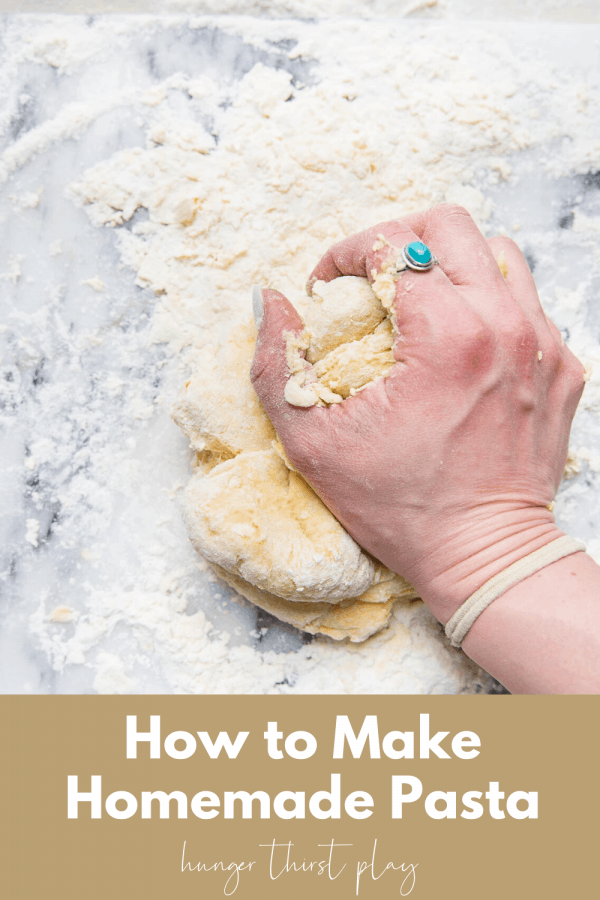



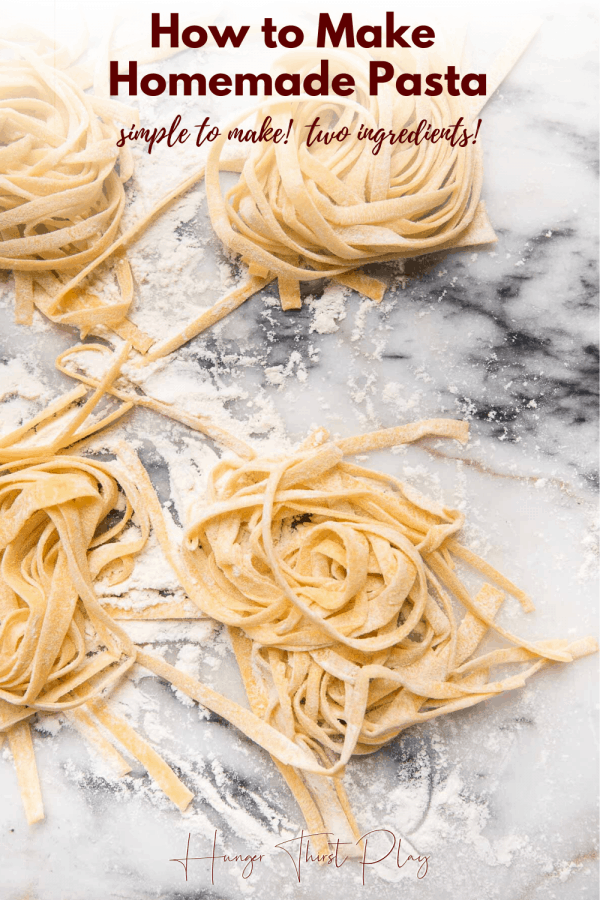
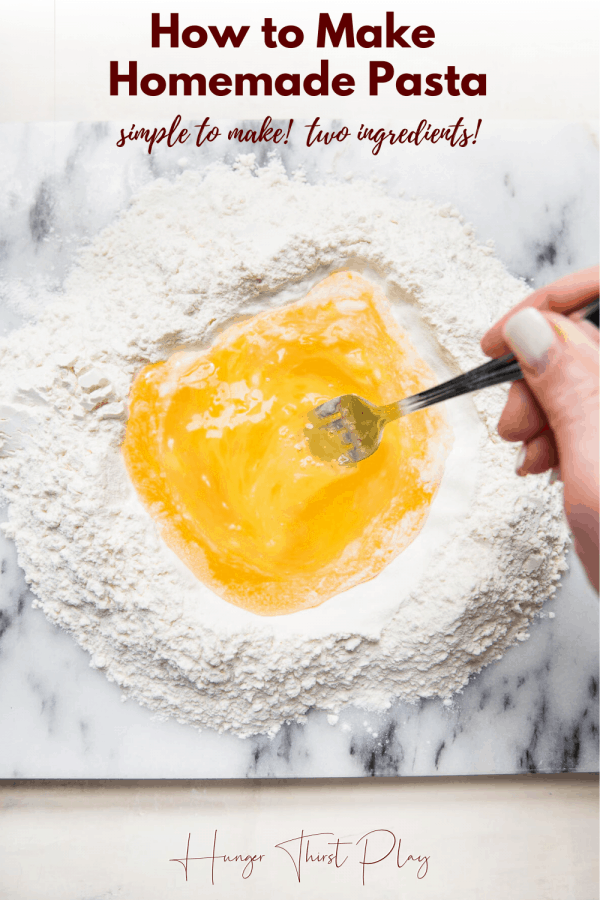


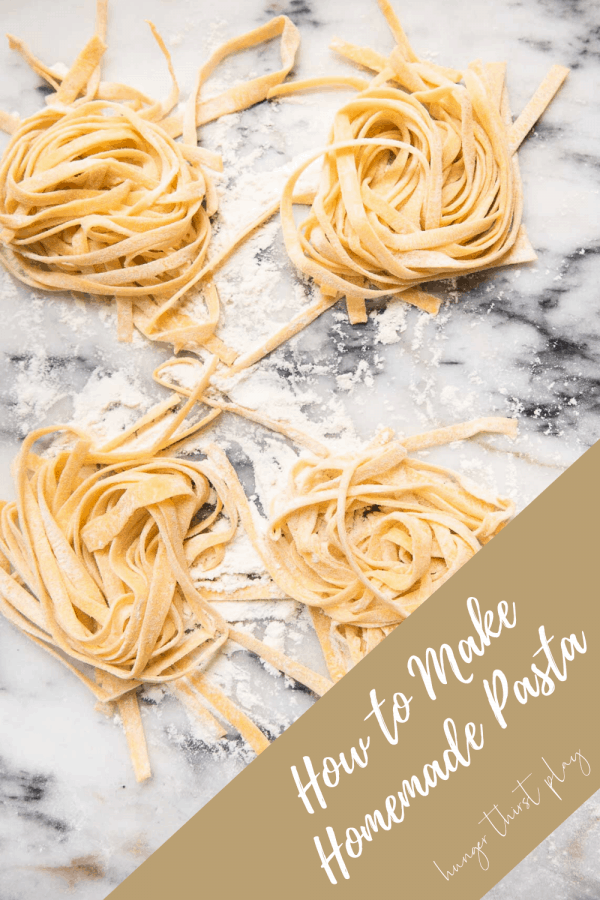

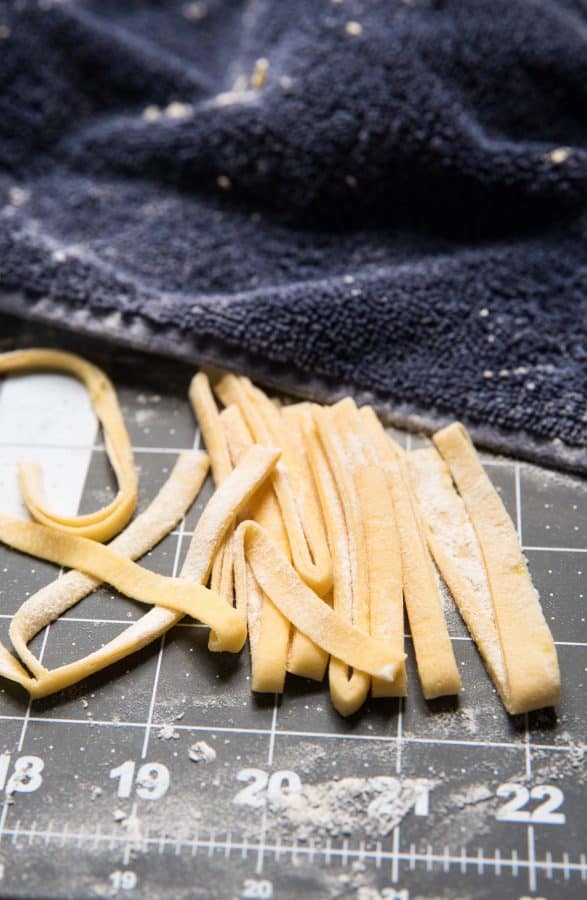
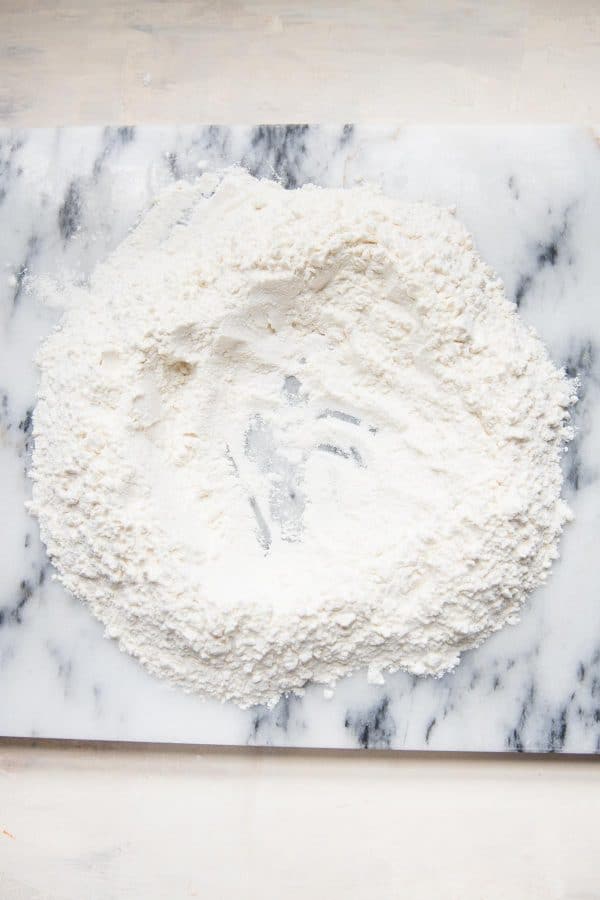
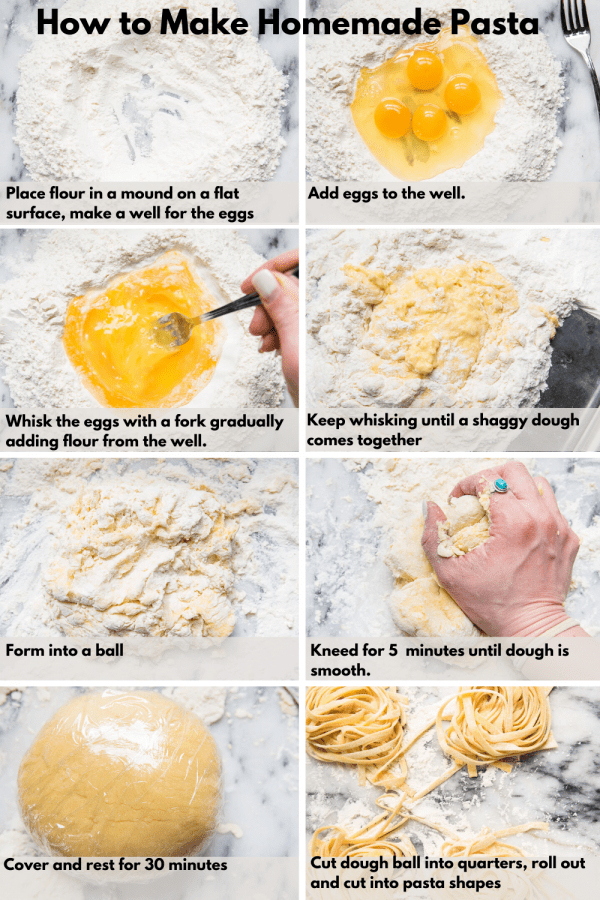
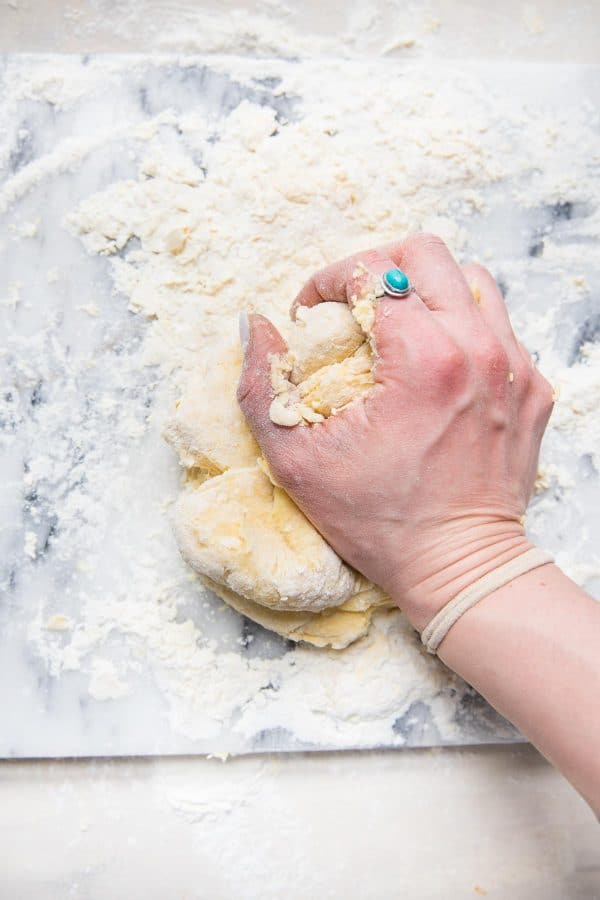
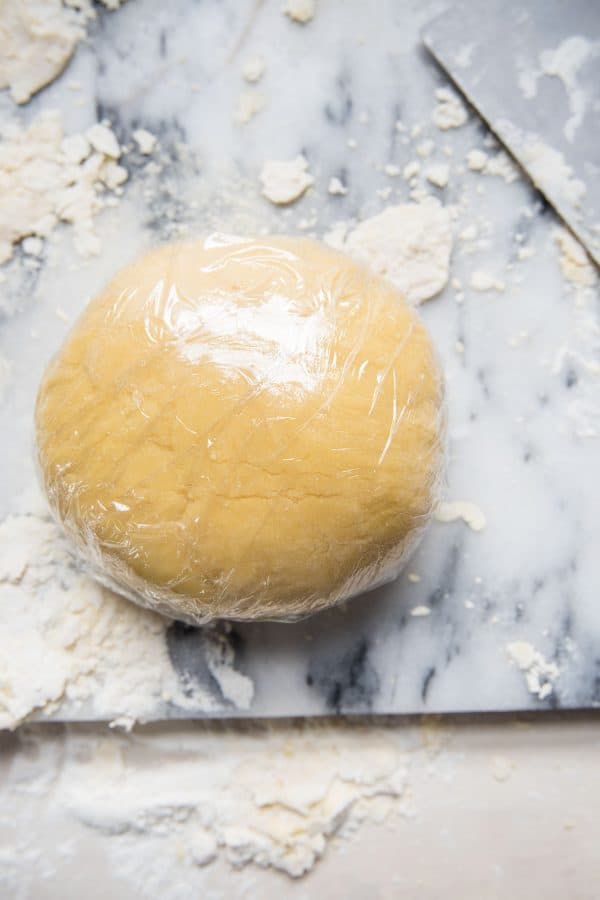
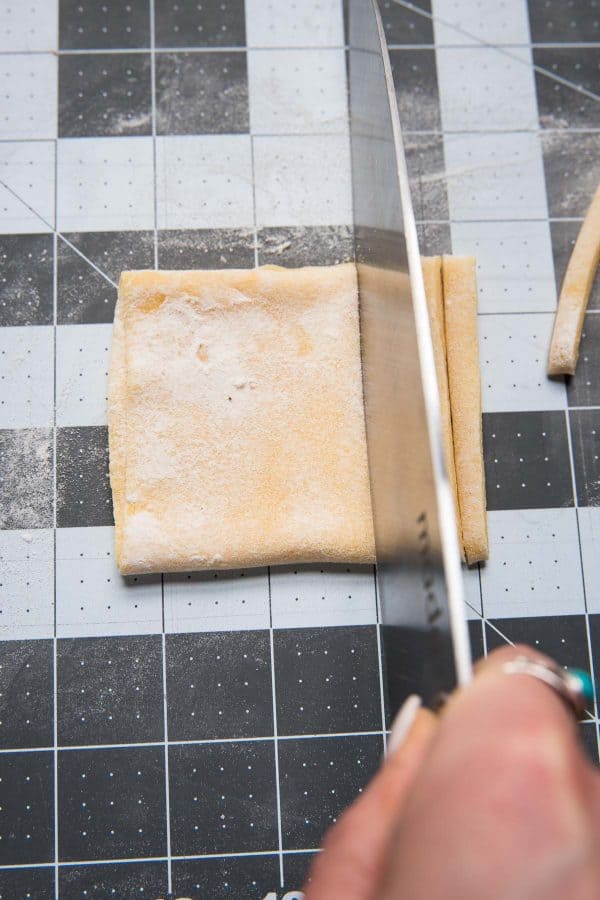


Andie says
Can I make the dough a day ahead? I see the rest period is 30 mins- but can it rest longer?
Lauren says
Yes! Just be sure to keep it covered (plastic wrap or ziplock bag) and in the fridge.
Debbie A says
made this 2x ...when we boil the pasta, which is shaped like a cavatelli, they are so hard!had to throw out!
2nd time we've cooked lot longer 15 min's , same. but the thinner it was the better it cooked. then i made/ shaped / rolled it out it w our pasta maker!! OMG So much easier... very very thin noodles. came out much better when we cooked it. but what are we doing wrong? or was that the secret. thinner pasta...not shapes. maybe the 001 flour for shaping or eggless dough.?
1st batch just semolina flour plus 4 eggs
2nd was 3/4 semolina w 1/4 all purpose plus 4 eggs
tips! appreciated.
i've also seen dough made w no eggs so?
Lauren says
Hi Debbie! Definitely recommend thinner rolled pasta for making the shapes if they came out hard or gummy after cooking. This recipe calls for all purpose or 00 flour. If you'd like to incorporate semolina flour, I recommend adding more eggs. Semolina flour has a courser grind and that might be the reason for the harder pasta!
Jennifer says
If freezing the pasta, do you thaw or cook from frozen?
Lauren says
You can cook from frozen!
Barbara says
I am definitely trying this .been wanting to make homemade pasta for years now after a brain aneurysm and stroke left me with use of only one hand. I felt cutting it would be too difficult . Today I ordered the pasta attachment for my kitchen aid. Excited to try this!
Lauren says
Let me know how it goes Barbara!!
Dot says
You can purchase a motor for the pasta machine. Makes rolling it out a breez
Royal says
Please can I bake the pasta before cooking it
Lauren says
If you're using it right after making it, I'd boil it first prior to making most dishes with it. If you're planning to use the pasta as sheets like for lasagna, you can use without boiling and just bake right away.l. If you're using the dough recipe in a pasta extruder to make shapes, you could bake those right away without boiling first as well.
Cdh says
I made your pasta recipe today. It came out pretty good. Thank you so much!
Laurie T. says
Can I let the mixer do the kneading or do I need to do this by hand? I have arthritis, so my hands aren't very strong.
Lauren says
Absolutely! You can definitely let the mixer knead, about 5 minutes.